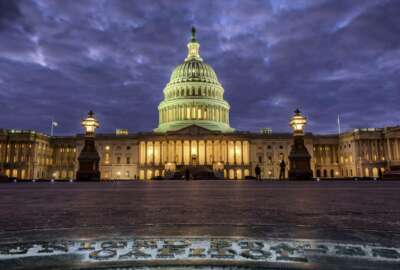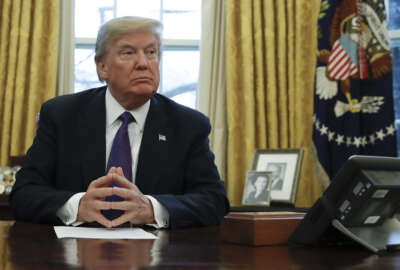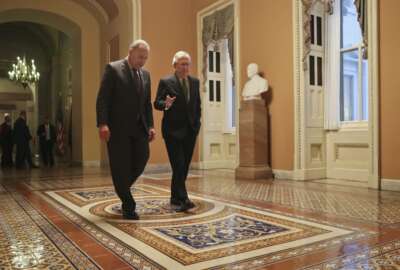
Why the president’s 2019 budget request was more of a ‘policy document’ than anything else
Preparing the president's most recent budget request was particularly challenging for the Office of Management and Budget this year.
Federal employees who saw workforce reductions and other cuts to their agency’s budget in the president’s 2019 budget request this week may want to delay their worst fears.
Most budget proposals from the White House contain several recommendations that never see the light of day after Congress finishes the subsequent appropriations process and passes a spending bill into law. But this year’s request from the White House couldn’t have come at a more inopportune time.
After putting off a budget for fiscal 2018 with four continuing resolutions, Congress finally struck a deal and decided to raise spending caps — putting an end to the sequester for the next two years that was supposed to kick in for 2018 and 2019.
The Bipartisan Budget Act of 2018, which Congress passed and the president signed on Feb. 9, sets spending caps — $300 billion higher than current levels — for the next two years. It sets the spending limit for defense agencies at $629 billion in fiscal 2018 and $647 billion in fiscal 2019, while domestic agencies would be authorized to spend no more than $579 billion and $597 billion this year and the next.
And with Congress’ agreement, the Office of Management and Budget had days — with an hours-long government shutdown in between — to revisit work it had done for months previously and update agency spending to comply with the numbers Congress had just set.
OMB worked through the weekend, Director Mick Mulvaney said, to update the president’s 2018 budget request to comply with the new congressional spending caps and release a document Feb. 12.
It did release a rough outline of how the Trump administration would like to spend the additional non-defense dollars that Congress set under new spending caps for 2018.
But OMB didn’t update its spending figures to match up with the new Bipartisan Budget Act figures.
“It will take us several weeks, if not months, to run that number through the system,” Mulvaney told the Senate Budget Committee Tuesday. “Instead of, however, waiting until April or May to give you this budget, we’ve decided to come forth with these numbers here today.”
Mulvaney said OMB will eventually update the president’s 2019 proposal to comply with the 2018 Bipartisan Budget Act spending caps.
For now, the White House’s fiscal 2019 budget resembles more of the president’s intentions on policy, and less on specific numbers.
“It remains a messaging document,” Mulvaney said of the 2019 request. “So what are those messages? There are two primary messages in what we bring to you today. Number one, you don’t have to spend all the money that you’ve just allocated or provided for [in] the caps, but if you do, here is how the administration would prefer to spend it. You don’t have to spend it all. And that’s what we’ve put in the [20]19 budget. Yes, we’ve added money back to the [20]19 budget, money in addition to what we would have sent you, if there was no caps deal.”
David Haun, a former deputy associate director with OMB and now a principal with Grant Thornton, said the president’s budget doesn’t often paint a truly accurate picture of what agencies might experience in the next year with their resources.
“The president’s budget every year, and the whole budget process, is far more than just a request for resources,” he said. “Because appropriations are considered must-pass legislation, the budget will always be the train that pulls along a lot of other policy objectives.”
Latest Budget News
For the Trump administration next year, it’s clear that significant increases in defense spending are one of those top priorities. The president’s 2019 request details workforce reductions at many civilian agencies, but as the White House wrote in its proposal, the cuts are merely estimates — an indication of where the Trump administration would like to spend its new-found dollars on in the coming year.
OMB and White House typically spend several months working with agencies on their budget submissions. Agencies will typically send their spending justifications for the future budget year to OMB in September.
Next, OMB will review each agency’s justification and send them back with comments to each organization around November, Haun said.
The “passback” process runs through December, as agencies and OMB continue to negotiate the final terms of the coming budget request.
“In order to publish the budget on the first Monday in February, Congress needs to give us … that appropriation by early December,” Haun said. “It takes time for us to load the database and then build out the new budget request and lock all that information in … by early January … It takes time to then digest all these spend levels and write the actual budget document and then send it off to [the Government Publishing Office] for printing.”
When Congress hasn’t designated appropriations by early December, OMB typically won’t make the deadline set in statute to release the next year’s budget request on the first Monday in February, Haun said.
That happened this year, and the White House pushed the date back to Feb. 12.
“Every administration is faced with this point in time where we have to make a decision: Are we going to try to meet the deadline of submitting the budget on time, or are we going to delay the budget?”
During his 33-year tenure at OMB, Haun said the agency opted to submit the budget on time more often than not.
“It makes it difficult to use the budget to actually explain what the difference is in terms of what we’re requesting for [20]19. We’ll have a better story if we can wait until we know what spending levels we [have] this year.”
Copyright © 2025 Federal News Network. All rights reserved. This website is not intended for users located within the European Economic Area.
Nicole Ogrysko is a reporter for Federal News Network focusing on the federal workforce and federal pay and benefits.
Follow @nogryskoWFED





